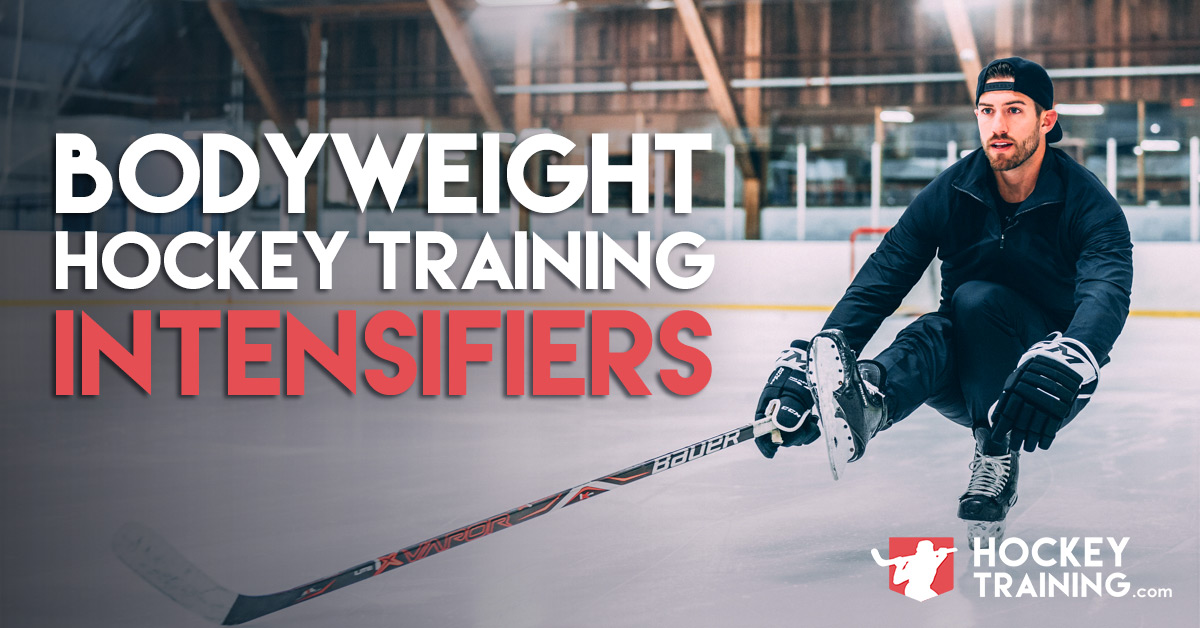A lot of people think that bodyweight-only training is too basic and that you are severely restricted in the results you can get from a particular program unless you incorporate a ton of fancy equipment.
Although there are some hints of truth to this in a particular context, the most common thing that holds people back in the effectiveness of their bodyweight-only programming is not equipment, but a lack of creativity.
Knowing how to progress and regress an exercise allows you to match the perfect intensity to your current abilities.
You can use a few simple techniques to regress or progress the intensity of any exercise to match the ability level of the hockey player. These techniques are the operational grounds at which we design programs here at Hockey Training.
They include your environment, the mechanical laws of physics, and quick tricks to add or reduce intensity to a certain movement (e.g. something as simple as where you place your feet can make a night and day difference).
Today, I want to explore some of these practical tweaks with you, so you can make any exercise I have prescribed for you here at Hockey Training just right to fit your current ability – whether it be that you need a regression or a progression.
Speed
Changing the speed of movement can change the intensity of any exercise. Generally speaking, the faster an exercise is, the harder it is.
This is because additional power is required to increase and then reduce the momentum produced by the speed. This is especially true of power-based movements, such as the many jump workouts I have provided you on this blog and on our YouTube channel.
For example, a bodyweight jump requires much more force during takeoff and landing than a bodyweight squat does.
However, speed can work in another way during some exercises as well. Slowing the speed of an exercise can increase the time under tension and the overall work performed, thereby increasing intensity as well.
For example, if you can perform 10 pull-ups really quickly, slowing you down to a 3-second ascension and a 3-second descension will increase the work done and likely only allow you to do 4 or 5.
Biomechanics
The lever arm of an exercise is the distance from a fixed point to where a force is applied. The longer the lever arm, the higher the load and the harder the exercise.
The easiest example to describe of lever arm manipulation comes from the push-up exercise. A full push up performed on the floor is much easier than performing push-ups with your hands up on a bench or when you are on your knees instead of your feet.
This is the case because the push up on the floor provides the longest lever arm from the fixed point (which is your feet) to the distal point (which would be your shoulders).
This exact same law applies everywhere, just think about the differences in weight you can use during a flat DB fly versus a flat DB bench press – or a DB lateral raise versus a DB shoulder press.
Foundation
The foundation at which you stand on can dramatically alter the intensity of an exercise.
Increasing your base of support is what is going to provide increased stability and balance, this leads to reducing the applied load at the stabilizing points and allowing you to execute the movement easier.
Decreasing your base of support puts a much greater load on the stabilizing points of the movement. For example, performing a one-legged DB Romanian deadlift is going to require more core and hip stability to maintain your technique in comparison to performing the exercise on two feet.
Because of the balance need, the load of the DB will need to be lighter and the speed of the movement will decrease.
Reducing your base of support also increases the load on the other base of support structures, for example, a one arm push-up puts a much greater load not only on the active arm – but also the core (which must avoid rotating and collapsing).
Range of Motion
Altering the range of motion of an exercise is one of the most efficient and simple ways in the book in order to progress or regress any given exercise.
Larger ranges of motion require more work and more control.
Smaller ranges of motion require less work and less control.
An example of this can be seen with reaching lunges. Alternating front reaching lunges to your feet is much harder than alternating front reaching lunges to your knee.
Another more obvious example would be the major difference between doing a deep squat or a quarter squat. Just a few inches in depth or range can turn a novice exercise into a highly advanced exercise.
A way in which to progress yourself in a simple way is to “pyramid” your program design. This is where a few reps are done at the hardest intensity, a few are done at a medium intensity, and the rest are done with an easy intensity.
Once this is repeated over time, the athlete will be able to do more and more work in the hardest intensity, and then eventually stay there consistently.
Final Thoughts
Although the above are all the most common ways in which to manipulate the intensity of hockey training exercises, there are many other ways as well.
The most obvious of which would be to add weights to the movement in the form of DB’s, BB’s, medicine balls, cables, or bands.
You can also add movement to the exercise, for example, adding a step up or rotation to a certain exercise to get a more complete result.
Creating a mental element, for example, reactive agility training is another way in which you can increase the intensity of a movement to bring you to a more advanced level.
Among many, many other ideas.
You are only limited by your creativity – find the progressions and regressions that work best for you and work within your current ability until you are able and ready for the next step up in difficulty.
If you’re looking for a bodyweight only hockey training program to help you improve your game check out the following programs: Bodyweight Hockey Training Program, 9-Minute Hockey Trainer, or At-Home Follow Along Program.


how about goalie programs
Yup — these work for goalie programs as well. You can also check out this blog: https://www.hockeytraining.com/goalie-training-lift-heavy/